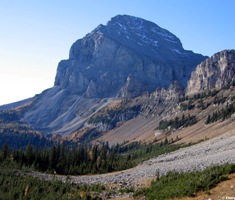
Maintaining habitat connectivity for wide-ranging carnivores along the Yellowstone-to-Yukon corridor in the face of increasing human activities is a major challenge. While national parks like Banff, Waterton Lakes, and Glacier receive international attention, the area between them has received far too little notice.
A particularly sensitive area is Crowsnest Pass (Alberta/British Columbia divide), where a major highway bisects the narrowest section of the Canadian Rockies. Roads, residential development, oil-and-gas exploration, logging, and unregulated ATV use all combine to fragment and degrade this critical corridor for bears, wolves, lynx, cougars and other predators.
WCS Canada has two projects that collectively work to ensure the survival of large carnivores in the Crowsnest Pass region. In the first initiative, John Weaver, Clayton Apps, and Paul Paquet have generated important information for six carnivore species grizzly bear, wolf, wolverine, lynx, bobcat, and badger) that have different ecological niches and scales of landscape use. At a finer scale, Global Positioning System (GPS) collaring of grizzly bears near Crowsnest Pass has provided detailed information regarding movements in relation to human developments such as the highway and other infrastructure.

The scientific knowledge gained from this research can be used to manage both wildlife and important landscape linkages. Already, for example, the Nature Conservancy of Canada and forestry company Tembec Inc., have used this information to create a protected matrix that includes 1,200 ha. purchased by the Conservancy, 2,900 ha. put under a conservation easement and 35,200 ha. that will be under a 10-year residential development moratorium. Continuing efforts will include the refinement of models identifying critical population cores and linkages through time; the formation of guidelines for conservation action at local and regional levels; and collaborative initiatives with public land managers as well as land owners and conversation groups.
The second part of the WCS Crowsnest Pass initiative is an effort led by Cheryl-Lesley Chetkiewicz and Mark Boyce that involves locating and quantifying the features of local wildlife corridors for grizzly bears and cougars in the Crowsnest Pass on the Alberta boundary. The team is developing new approaches for identifying corridors based on detailed movement and habitat selection data for grizzly bears and cougars.